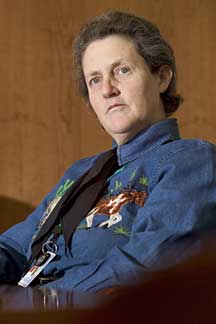Autistic mind well suited for animal-based study - both involve thinking in pictures, explains visiting professor Grandin
By Alex Kwan

A distant windmill or a stray piece of yellow tape may seem insignificant, but their presence can cause such fear in cattle awaiting slaughter that entire meat plants can be brought to a halt.
This was the scenario presented by renowned animal scientist Temple Grandin, a Frank H.T. Rhodes Class of '56 Professor at Cornell, in a public lecture Feb. 15 in Statler Auditorium.
Grandin is autistic, and as a result she thinks by putting what she sees into categories. This has strong parallels, she believes, to the way animals think.
"I don't think in language. I think in pictures," said Grandin, an associate professor of animal science at Colorado State University and a noted designer of livestock handling facilities. Her designs, including a center track restrainer system that handles almost half of the cattle in North America, have been adopted around the world.
"How does an animal think? They sort pictures into categories. Forming categories is the beginning of thinking," said Grandin. Using guide dogs for the blind as an example, she spoke of the need to train the dogs at many types of intersections with different crosswalk patterns and stop signs so that the animals eventually will make visual connections to situations in general.
Since sensory details are important, Grandin argued that the autistic mind is well suited for animal-based study. "The normal brain tends to drop out details, but the autistic brain tends to pick up details," said Grandin, who suggested that animals notice details that people normally do not. Such sensory stimuli as sounds and smell are as intruding for animals as they are for autistics, she said.
"People don't realize how much of a problem these sensory sensitivities cause," said Grandin. She pointed out that high-pitched noises and rapid movements also can be highly stressful. Such sensory bombardments can easily lead to anxiety and panic attacks in autistics. "Fear is the main emotion in both animals and people with autism," she added.
Since 1997, Grandin has consulted for McDonald's as an animal welfare adviser and a beef-supplier auditor. Instead of plowing through documents, she insists on evaluating suppliers with a scoring system that measures outcomes during slaughtering. She assigns penalty points for the use of electric prods, the rate of animals falling down and the number of animals bellowing. Grandin suggested that such objective evaluations have helped vastly improve animal welfare in the last several years.
Grandin is probably best known, however, for her books about autism; "Thinking in Pictures" and "Emergence: Labeled Autistic" were bestsellers; her latest title "Animals in Translation," which relates animal thinking to autism, is currently on the New York Times' best sellers list.
Grandin started her career by writing columns for a regional livestock periodical before she slowly built up a portfolio of design work. "It is about developing a talent into a skill that other people want: designing cattle handling facilities," said Grandin, who could imagine three-dimensional structures but had difficulty with arithmetic. These days she takes every opportunity to express her concern for the lack of career guidance offered to autistic children. "You can't become what you don't know. I had great early intervention," said Grandin, "My science teacher gave me a reason to study."
Alex Kwan is a writer intern with the Cornell News Service.
Media Contact
Get Cornell news delivered right to your inbox.
Subscribe